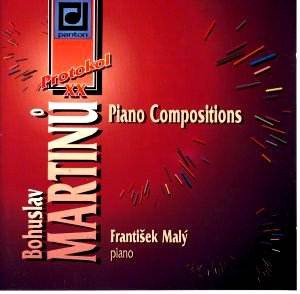The Fantaisie is well named being both desperate
and hectic, lyrically winged and contemplative. The Toccata
(a form Martinů grouped with two song movements to create his Toccata
e Due Canzoni for piano and orchestra) is more dissonant. It is
also reflective of the fracture of the
times and of his anger at having had to leave Paris in such turmoil
rather than face the Gestapo. If he had stayed he would no doubt have
met the fate of the family of one of his foremost exponents, the conductor
Karel Ančerl. All of Ančerl's family were killed. Like
the Etudes and Polkas, this is ripely
vintage Martinů from the years of his symphonic 'explosion' in
the USA. Indeed the contemporaneous Fourth and Fifth Symphonies smile
from these pages but with a skim of sourness and disillusion largely
tacit in the symphonies.
The Etudes and Polkas were written at Cape Cod
between the end of July and the end of September 1945. These marry homesickness
for Czechoslovakia (all the more poignant given that he was never to
return to his homeland), folk curved melodies, eloquence of expression
and the symphonic impetus of symphonies 3 to 5. Highlights include the
galloping vivo third movement of Book 1. Martinů
hallmarks litter these completely characteristic scores. The Etudes
are not academic at all with Martinů channelling authentic emotion
into them quite undiluted. The three books alternate Etudes
and Polkas in brief and succinct paragraphs - most movements are
about two minutes long. Books 2 and 3 each have five movements; Book
1 has six. Instead of a 'plain' 'Etude', Book 3 has a 'Danse-Etude'.
Book 1 interposes an additional movement (Pastorale) between the final
Polka and Etude.
The Sonata is his only one for solo piano. It was written
for that other great pianist friend of his American 1940s, Rudolf Serkin.
Nice was the backdrop for the writing of the Sonata. There Martinů
was staying in the hope (never consummated) of a move back to his native
Czechoslovakia. It lacks the line and easily articulate flow of the
symphonies and marks a return to the surreal fantasy of his 1930s opera,
Julietta. Along the way, in the three movements, the reference
points include Beethoven, Brahms and the grotesquerie of Prokofiev.
Incidents flow and slip with careless restlessness.
Interestingly the layout and sequence of this disc
is exactly the same as the last disc in Supraphon's complete Martinů
piano music (Emil Leichner 11 1010-2 133, 3 CDs). That disc plays for
69.34 against Malý’s 71.35.
Eleonora Bekova recorded the Sonata in 1997 for Chandos
(CHAN 9655) and the sound of her piano is richer - presumably a factor
of a superior instrument and the much warmer acoustic of the Maltings,
Snape. The overlay of warmth is not entirely an advantage. The greater
clarity and the absence of an ambient aura is preferable though Bekova's
harried nightmare hunt in Fantaisie et Toccata is superior to
Malý's.
This disc was sponsored by the Bohuslav
Martinů Foundation.
A worthy collection serving as a better than decent single disc introduction
to Martinů's piano output.
Rob Barnett

